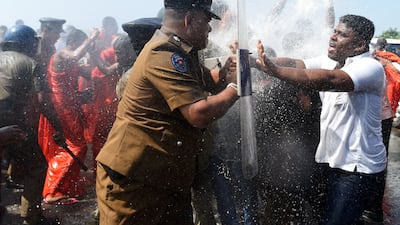AMBALANTOTA, Sri Lanka // At least 21 people were hurt in violent clashes between Sri Lankan government supporters and villagers marching against a plan to turn private land into an industrial zone mostly owned by China.
Police used tear gas and water cannons to try to break up the fighting, which took place as prime minister Ranil Wickremesinghe was attending an opening ceremony for the industrial zone, located near the port city of Hambantota.
The clashes began when government supporters started throwing rocks at villagers who were marching to the ceremony site. The protests, organised by the opposition and led by Buddhist monks, responded by throwing rocks at the government supporters. A group that appeared to have been transported to the area by the government joined in attacking the protesters with poles.
Twenty-one people, including three police officers, were taken to hospital in Hambantota, a hospital official said.
Sri Lanka’s government has signed a framework agreement for a 99-year lease of the Hambantota port with a company in which China will have 80 per cent ownership.
Officials also plan to set up a nearby industrial zone where Chinese companies will be invited to set up factories. The villagers and monks are opposed to it and demand their residential and farmlands be spared.
A court had issued a restraining order on the protest, saying it could lead to unrest, but the protesters defied it.
Mr Wickremesinghe inaugurated the industrial zone despite the clashes. Speaking at the ceremony, China’s ambassador to Sri Lanka, Yi Xianliang, said his country hopes to invest US$5 billion (Dh18.36bn) in the region within the next five years, and the new industries are expected to generate 100,000 jobs.
China invested more than $1.2bn in the port in what some analysts call its “string of pearls” strategy in countries surrounding its rival India.
Although the project has suffered losses since 2010, Sri Lanka’s government, at first critical of the enterprise, approached China to seek help to make it viable.
Lawmaker D V Chanaka, one of the protest organisers, said he feared the port area will become a “Chinese colony”.
“We are against leasing the lands where people live and do their farming, while there are identified lands for an industrial zone,” Mr Chanaka said. “When you give away such a vast area of land, you can’t stop the area from becoming a Chinese colony.”
Magama Mahanama, from a group calling itself the Monks’ Organisation to Protect National Assets, said that the clergy, following an ancient tradition, would issue a decree to the government to stop the leasing. Historically, kings in predominantly Buddhist Sri Lanka are said to have abided by decrees issued by Buddhist monks.
“It’s a way of conveying the message that the monks are not for it,” he said.
* Associated Press

